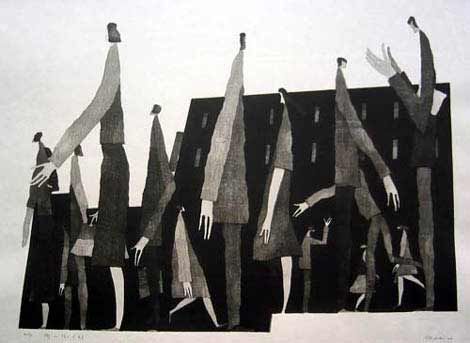Stop Thinking Like An Artist, And Start Thinking Like An Entrepreneur

Okay, so you have your work completed and ready, you’ve got an idea, you’ve got an army of supporters willing to back you up no matter what, and you’ve made a mental list of all the potential resources to make it all happen. Now, the only thing that’s missing is ______.
THE RIGHT ATTITUDE.
Many times we find ourselves making this common mistake. We check off the the “wishing” part, but we overlook the attitude that is needed to actually transform our ideas into products. The artist within us did its job, but now what are some steps we can take to awaken the entrepreneurial side within us?
Just Do It
As this article quoting some of Richard Branson‘s most encouraging quotes mentions:
“Screw it, just get on and do it.”
Why wait on an idea and splash around on the baby-side of the pool when you can swim to the end and win the race? If you have a vision, get on with connecting the dots and making the big picture happen.
Pay attention to your hunch
We have a tendency to overlook the mistakes others around us are making, whilst thinking we’ve got it all under control.
On that note, this is what David McRaney has to say about the productive, creative and the successful crowd that seems to be missing half of the equation:
“You must remind yourself that when you start to pick apart winners and losers, successes and failures, the living and dead, that by paying attention to one side of that equation you are always neglecting the other.”
This notion by him is best explained in the article: How To Create Your Own Luck
“If you think that one input creates one output, you’re employing linear thinking.”
“…the savviest entrepreneurs cooperate with unpredictability…”
“Luck–in business and in life–isn’t something that happens to you, it’s something that you look out for, and in looking out for it, participate in the creation of.”
Point being, if we only water the artist side of our thinking, we may find ourselves jumping from one idea to another within blinks. So, by paying attention and being open to our entrepreneurial side, we’ll work towards transforming our ideas into products.
Consider: Wantrepreneur vs. Entrepreneur
According to Henry Jinman, a wantrepreneur (as he calls himself), everyone could be seen as a “wantrepreneur,” until he/she makes it. He favors the word as an adjective, more than it’s value as a noun. Here is why,
Entrepreneurial: The Adjective
“As an adjective the word works. It means a similar thing to everyone. I think we would all universally see an entrepreneurial person as one who:
-Is good at solving problems.
-Is reasonably good with money.
-Has lots of ideas.
-Is independent; “As an adjective, the meaning is a lot less serious. ‘Entrepreneurial’ is a part of who you are, whereas ‘entrepreneur’ is an entire definition of who you are.”
Moreover, with something we can relate to, he explains how his idea of the word started to change,
“I am still not comfortable calling myself an ‘entrepreneur’ but my view is changing. It has changed a lot this week and here is why.
This week I moved into rented accommodation. I have a study at home and soon an office on campus. I am working a second job to afford to live and I am working all the time. I am doing it. It’s hard but I am doing it. The excitement of a new desk or new office quickly fades. I have meetings, stakeholders and hopefully soon clients and customers but there is still a feeling of isolation. I am on my own and solely responsible for my success or failure.
The ideas of ‘doing it,’ ‘working all the time’ and ‘sole responsibility for success or failure’ are just more ‘wishy-washy’ epithets to add to the indistinct lexicology of the word ‘entrepreneur.’ I think, in my own mind at least, I am a committed ‘wantrepreneur’ until my business is incorporated and I can legitimately call myself ‘Founder and CEO’.”
And finally, in a different article, he speaks about the irony of his situation,
“I am in somewhat of a quandary. I am suffering from the problem I am trying to solve.”
The idea is this: at times, pointing out the problem itself isn’t the start of the solution. At times, the options we have to solve the problem can be problematic. The basic gist is- define yourself. The only person standing between the you now and the you then, is you. So a change in your attitude and your perception of yourself, may just be the accelerator you’ve been looking for.
After all, we are encouraged to say “Screw it, just get on and do it!”



